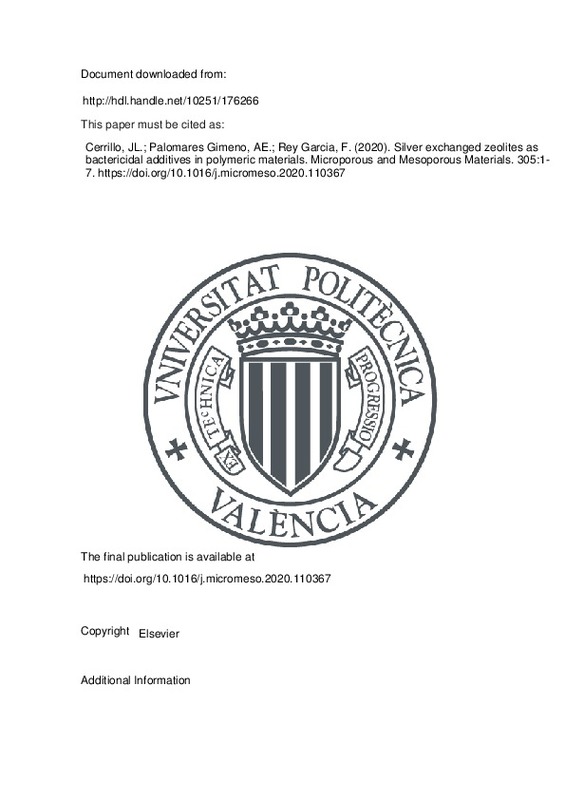JavaScript is disabled for your browser. Some features of this site may not work without it.
Buscar en RiuNet
Listar
Mi cuenta
Estadísticas
Ayuda RiuNet
Admin. UPV
Silver exchanged zeolites as bactericidal additives in polymeric materials
Mostrar el registro sencillo del ítem
Ficheros en el ítem
| dc.contributor.author | Cerrillo, J. L.
|
es_ES |
| dc.contributor.author | Palomares Gimeno, Antonio Eduardo
|
es_ES |
| dc.contributor.author | Rey Garcia, Fernando
|
es_ES |
| dc.date.accessioned | 2021-11-05T14:06:59Z | |
| dc.date.available | 2021-11-05T14:06:59Z | |
| dc.date.issued | 2020-10-01 | es_ES |
| dc.identifier.issn | 1387-1811 | es_ES |
| dc.identifier.uri | http://hdl.handle.net/10251/176266 | |
| dc.description.abstract | [EN] In this work, different Ag-zeolites have been evaluated as biocide materials against two common bacteria, displaying an excellent bactericidal activity in different media. The results demonstrate that the amount of silver, the type of zeolitic structure and the zeolite Si/Al ratio strongly influence on their bactericidal activity. The higher Ag amount, the better antimicrobial activity. Also, zeolites having large pore openings and Si/Al ratio close to 2 have shown the highest biocidal activity. The characterization of Ag-zeolites by different techniques shows that the incorporation of Ag at the zeolites does not alter the zeolite structure and that Ag is incorporated as Ag+ cations. The most promising Ag-zeolites with a Si/Al ratio of 2 were introduced in a polymer matrix of polypropylene, showing very high biocide activity against S.aureus. The applicability of the resulting Ag-zeolite-polymer material is limited because its darkening due to the presence of reduced silver species. The incorporation of a photo-stabilizer does not decrease the biocide activity, while maintains the original color of the polypropylene polymer. It has been shown that lixiviated Ag+ cations are the biocide active species. These Ag-species are released even when the Ag-zeolite is incorporated into the polymer, providing bactericide effects to the final Ag-zeolite-polymer composite. | es_ES |
| dc.description.sponsorship | The authors thank the Ministerio de Ciencia, Innovaci.on y Universidades, Agencia Estatal de Investigaci.on and Fondo Europeo de Desarrollo Regional through RTI2018-101784-B-I00 (MCIU/AEI/FEDER, UE) and SEV-2016-0683 for the financial support. J.L. Cerrillo wishes to thank MINECO for the Severo Ochoa PhD fellowship (SVP2014-068600). | es_ES |
| dc.language | Inglés | es_ES |
| dc.publisher | Elsevier | es_ES |
| dc.relation.ispartof | Microporous and Mesoporous Materials | es_ES |
| dc.rights | Reconocimiento - No comercial - Sin obra derivada (by-nc-nd) | es_ES |
| dc.subject | Silver | es_ES |
| dc.subject | Zeolites | es_ES |
| dc.subject | Biocide | es_ES |
| dc.subject | Polymer | es_ES |
| dc.subject | Composite | es_ES |
| dc.subject.classification | INGENIERIA QUIMICA | es_ES |
| dc.title | Silver exchanged zeolites as bactericidal additives in polymeric materials | es_ES |
| dc.type | Artículo | es_ES |
| dc.identifier.doi | 10.1016/j.micromeso.2020.110367 | es_ES |
| dc.relation.projectID | info:eu-repo/grantAgreement/AEI/Plan Estatal de Investigación Científica y Técnica y de Innovación 2017-2020/RTI2018-101784-B-I00/ES/NUEVOS MATERIALES ZEOLITICOS PARA PROCESOS DE SEPARACION SELECTIVA DE GASES, APLICACIONES MEDIOAMBIENTALES Y CONSERVACION DE ALIMENTOS/ | es_ES |
| dc.relation.projectID | info:eu-repo/grantAgreement/MINECO//SVP-2014-068600//SVP-2014-068600/ | es_ES |
| dc.relation.projectID | info:eu-repo/grantAgreement/MINECO//SVP-2014-068600/ES/SVP-2014-068600/ | es_ES |
| dc.relation.projectID | info:eu-repo/grantAgreement/MINISTERIO DE ECONOMÍA, INDUSTRIA Y COMPETITIVIDAD//SEV-2016-0683//Programa Estatal de Fomento de la Investigación Científica y Técnica de Excelencia/ | es_ES |
| dc.rights.accessRights | Abierto | es_ES |
| dc.contributor.affiliation | Universitat Politècnica de València. Departamento de Ingeniería Química y Nuclear - Departament d'Enginyeria Química i Nuclear | es_ES |
| dc.contributor.affiliation | Universitat Politècnica de València. Instituto Universitario Mixto de Tecnología Química - Institut Universitari Mixt de Tecnologia Química | es_ES |
| dc.description.bibliographicCitation | Cerrillo, JL.; Palomares Gimeno, AE.; Rey Garcia, F. (2020). Silver exchanged zeolites as bactericidal additives in polymeric materials. Microporous and Mesoporous Materials. 305:1-7. https://doi.org/10.1016/j.micromeso.2020.110367 | es_ES |
| dc.description.accrualMethod | S | es_ES |
| dc.relation.publisherversion | https://doi.org/10.1016/j.micromeso.2020.110367 | es_ES |
| dc.description.upvformatpinicio | 1 | es_ES |
| dc.description.upvformatpfin | 7 | es_ES |
| dc.type.version | info:eu-repo/semantics/publishedVersion | es_ES |
| dc.description.volume | 305 | es_ES |
| dc.relation.pasarela | S\420371 | es_ES |
| dc.contributor.funder | European Regional Development Fund | es_ES |
| dc.contributor.funder | Ministerio de Economía y Competitividad | es_ES |
| dc.contributor.funder | Ministerio de Ciencia, Innovación y Universidades | es_ES |
| dc.contributor.funder | MINISTERIO DE ECONOMÍA, INDUSTRIA Y COMPETITIVIDAD | es_ES |







![[Cerrado]](/themes/UPV/images/candado.png)

